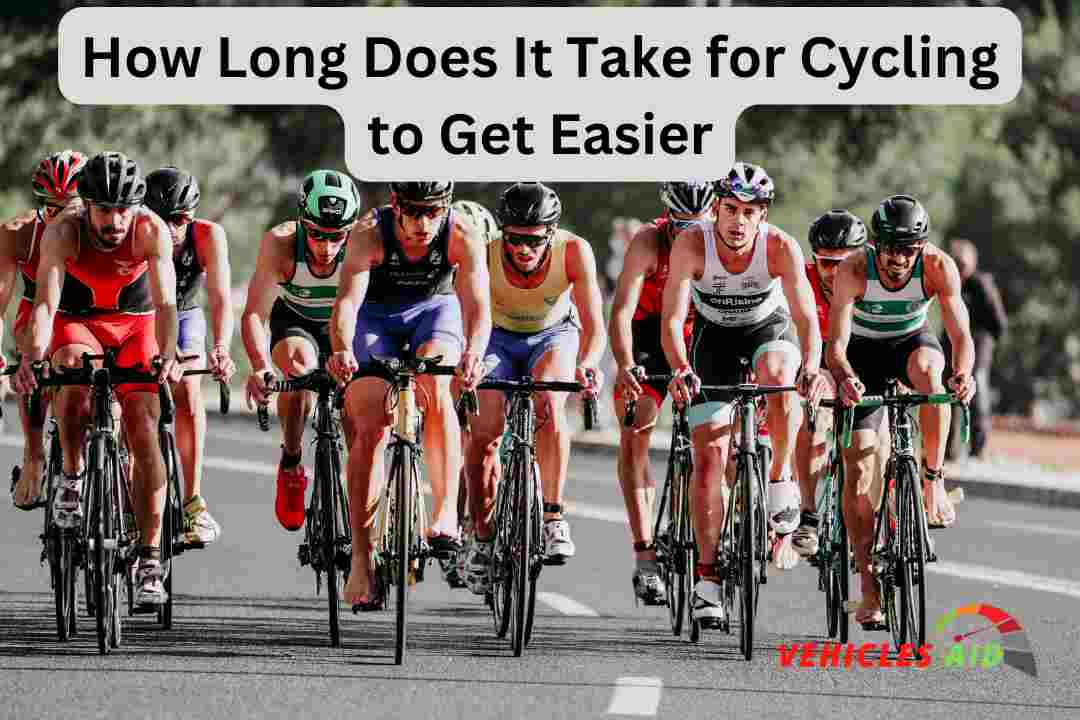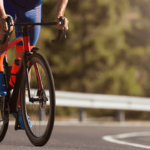If you’re new to cycling, it’s normal to feel like every pedal stroke is a battle. You may be asking yourself, “How long does it take for cycling to get easier?” The good news is that with a little bit of time and effort, things will start to click and you’ll find yourself feeling more comfortable on the bike.
Here are a few tips to help make the transition smoother. First, remember that taking breaks is perfectly okay. If you need to stop and catch your breath, don’t be afraid to do so.
It’s better to take a breather than push yourself too hard and risk burning out or having an accident. Second, try not to compare your progress to others. Everyone learns at their own pace and there’s no need to rush things.
You’ll get there eventually! Finally, focus on enjoying the process. Yes, there may be some tough moments but savor the good ones too.
The fresh air, the wind in your hair, the sense of accomplishment after reaching the top of a hill…these are all things that make cycling worth it. So hang in there and before you know it, cycling will start feeling like second nature!
When it comes to cycling, there is no one-size-fits-all answer to the question of how long it takes for things to get easier. However, with a bit of patience and persistence, most people find that their endurance and skills improve steadily over time. For beginners, even short rides can feel challenging at first.
But as you keep at it, you’ll gradually be able to go further and faster without feeling so winded. In general, it takes most people several weeks or even months of regular riding before they start seeing significant improvements in their fitness levels.
Of course, everyone progresses at different rates depending on factors like genetics, age, previous athletic experience, etc.
So don’t get discouraged if you don’t see results as quickly as some of your friends or family members who might also be taking up cycling. Just focus on enjoying the journey and trust that your hard work will eventually pay off!
How Long Should I Cycle As a Beginner?
If you’re new to cycling, the question of how long to cycle may loom large. How much is too much? What’s a safe amount for a beginner?
The answer, as with most things in life, is that it depends. It depends on your fitness level, your goals, and how much time you have to devote to cycling. But there are some general guidelines you can follow.
If you’re just starting out, aim for 30 minutes of riding two or three times per week. This will give you time to get used to the movement and build up your strength and endurance without overdoing it.
If you have more time available or if you’re feeling ambitious, you can increase the duration of your rides or the frequency (riding five days a week instead of three, for example).
Just be sure to listen to your body and don’t push yourself too hard. Once you’ve been cycling for a while and have built up some base mileage, you can start thinking about longer rides on the weekends or even multi-day bike tours. But even then, it’s important not to bite off more than you can chew.
Start with shorter rides and work up to longer ones gradually. And always remember that rest is an important part of training; don’t try to do too much too soon or burnout could set in quickly.
So there’s no need to worry about how long your rides should be when starting out Cycling; just go at a comfortable pace and Build Up Gradually.
How Can I Make Cycling Easier?
Assuming you want tips to make cycling easier:
1. Get a bike that fits you. This is probably the most important tip. If your bike is too big or too small, it will be very difficult to ride.
2. Don’t try to go too fast at first. Start off slowly and gradually increase your speed as you become more comfortable with riding.
3. Find a route that is relatively flat. It’s much easier to ride when you don’t have to deal with hills!
4. Invest in some good quality cycling gear. This includes things like a helmet, comfortable shoes, and padded shorts (if you plan on riding for longer periods of time).
5. Make sure your bike is properly maintained. This means regularly cleaning it and keeping an eye on things like the tires, chain, and brakes.
How Many Times a Week Should I Cycle to Improve?
Assuming you’re asking how often you should cycle to see fitness improvements, the answer is that it depends on a few factors. If you’re just starting out, riding a couple of times a week will be fine. As you get fitter, you’ll want to ride more often to keep seeing results.
Generally speaking, three or four times a week is enough for most people to see good progress. Of course, how hard you ride also makes a difference. If you’re just going for an easy spin around the block, you won’t see the same results as if you’re putting in some serious training sessions.
So, intensity matters too. A good rule of thumb is to try and do at least one longer ride (over an hour) and one shorter, faster rides each week. This will help keep your body guessing and prevent boredom from setting in.
So there’s no definitive answer to how often you should cycle to improve – it really varies from person to person. Just make sure you enjoy it and don’t overdo it, and you’ll soon start seeing those fitness gains!
Why Do I Find Cycling So Hard?
There are a few reasons why you might find cycling hard. Maybe you’re just starting out and haven’t built up your endurance yet. Or, it could be that you’re not used to pedaling with your legs in a crouched position.
Whatever the reason, there are ways to make cycling easier. One way to make cycling less hard is to start slowly and build up your endurance over time. If you try to do too much too soon, you’ll just end up exhausted and frustrated.
Start by taking short rides and gradually increase the distance as you get more comfortable on the bike. Another thing you can do is vary your riding position to give your muscles a break. Sometimes riding with your legs straightened out will be easier than always being in a crouch.
Of course, it’s also important to make sure that your bike is properly adjusted for your height and size. A bike that’s too big or small can make pedaling really difficult. If you’re still having trouble after trying these things, then it might be time to consult a professional cyclist or coach for help.
The biggest barriers to bike commuting and tips for overcoming them
(Credit: www.youtue.com)
How to Bike to Work Without Getting Sweaty
If you’re looking to bike to work without getting sweaty, there are a few things you can do. First, make sure you have the right gear. You’ll want to invest in a good quality bike and helmet that fit well.
You’ll also want to dress appropriately for the weather. In warm weather, light-colored, breathable fabrics will help keep you cool. In cooler weather, layers will help you stay warm while biking.
Second, take your time and start slow. If you try to go too fast or too far at first, you’re likely to get sweaty and exhausted. Build up your endurance gradually so that by the time you’re ready for your commute, biking won’t be such a chore.
Finally, be prepared for your arrival. Have a towel and clean clothes ready so that you can freshen up when you get to your destination. A quick shower is also an option if you have access to one at work.
With a little planning and preparation, biking to work doesn’t have to be a sweaty ordeal!
Sweating While Cycling
Sweating while cycling is a common occurrence, especially during hot weather. While it may be uncomfortable, sweating is actually a good thing as it helps to regulate your body temperature and keep you cool. However, there are a few things you can do to help minimize sweating while cycling.
First, make sure to dress appropriately for the conditions. Wearing light-colored, breathable clothing will help to keep you cooler than dark colors or heavier fabrics. Also, avoid wearing synthetic fabrics next to your skin as they tend not to breathe as well and can trap heat and sweat against your body.
Secondly, stay hydrated before, during, and after your ride. Drinking plenty of fluids will help replace the electrolytes lost through sweating and will also help keep your body temperature down. Avoid sugary drinks or those with caffeine as they can actually cause you to sweat more.
Finally, try using a chamois cream or talcum powder on your skin before getting dressed for your ride. This will help create a barrier between your skin and clothing and will also absorb some of the sweat produced by your body.
Excessive Sweating While Cycling
If you find yourself sweating excessively while cycling, there are a few things that could be the culprit. It could be the weather, your fitness level, or what you’re wearing. The weather is obviously a major factor in how much you sweat.
If it’s hot and humid out, you’re going to sweat more than if it’s cooler and dry. There’s not much you can do about the weather, so just make sure you dress appropriately and drink plenty of fluids. Your fitness level also plays a role in how much you sweat.
If you’re just starting out, your body isn’t used to the exercise and will sweat more as it tries to regulate its temperature. As you get fitter, your body will become more efficient at regulating its temperature and you’ll sweat less. Finally, what you’re wearing can also affect how much you sweat.
If you’re wearing heavy clothing or layers, your body will have to work harder to cool itself down and you’ll end up sweating more. Wearing lighter-weight fabrics will help keep you cooler and help reduce sweating. If excessive sweating while cycling is something that bothers you, try these tips to help reduce it.
And remember, as your fitness level improves, so will your ability to handle the heat!
Raincoats for Cycling
When you are out cycling, getting caught in a rain shower can be a real pain. Not only is it wet and cold, but it can also ruin your clothes and equipment. That’s why having a good raincoat is essential for any cyclist.
There are a few things to consider when choosing a raincoat for cycling. First, you need to make sure that the coat is waterproof. There are many coats on the market that claim to be waterproof but are not really up to the task.
Make sure to read reviews before purchasing to ensure that you are getting a quality product. Second, you need to make sure that the coat is breathable. This is important because if it isn’t breathable, you will end up sweating underneath the coat which will make you even colder.
Again, reading reviews online can be helpful in finding a good quality product. Finally, you need to make sure that the coat fits well. If it is too big or too small, it will be uncomfortable to wear while cycling and could potentially cause accidents if it gets caught on something while you are riding.
Most coats come in sizes small, medium, large, and extra-large so there should be no problem finding one that fits well. So there you have it! A few things to consider when choosing a raincoat for cycling.
Make sure it is waterproof, breathable, and fits well and you’ll be all set for your next rainy day ride!
Google Maps Bike-Friendly Roads
Google Maps is a great resource for finding bike-friendly roads in your area. When searching for directions, simply click the bicycle icon in the top menu bar. This will display bike paths and trails in green, and regular roads in gray.
You can also toggle between different map views to see satellite imagery or terrain. Biking is a great way to get around town, and it’s good for your health too! With Google Maps, it’s easy to find routes that avoid busy streets and hills.
So next time you’re planning a trip, hop on your bike and enjoy the ride!
How to Use Gears on a Bike for Beginners
If you’re new to bicycling, understanding how to use gear can be confusing.
Here’s a quick guide on how to use gears on a bike, whether you’re riding on the road or on trails. On most bikes, there are two main types of gear: derailleurs and cassettes.
Derailleurs are located at the back of the bike near the rear wheel and are used to shift between different-sized cogs (or teeth) on the cassette.
Cassettes are located on the front of the bike next to the pedals and usually have fewer cogs than derailleurs. To shift gears, you’ll need to use your left hand if you’re riding on the road or your right hand if you’re riding off-road.
For example, if you’re riding up a hill, you’ll want to shift into a lower gear so that it’s easier to pedal. To do this, simply click the shifter lever (located near your handlebars) towards you with your thumb until you hear or feel a click.
This will disengage the current cog and allow you to rotate freely through the cogs until you hear or feel another click, which indicates that it’s engaged again.
You can then start pedaling in that gear. If you’re going downhill, you’ll want to shift into a higher gear so that pedaling is easier. To do this, click the shifter away from you with your thumb until you hear or feel a click.
Once again, keep rotating through the cogs until you find one that feels comfortable before clicking it back into place so it’s engaged again. It may take some practice to get used to shifting gears smoothly without pedaling erratically, but eventually, it will become second nature!
Bike Lane Map
Welcome to the Bike Lane Map! This map will show you all of the bike lanes in your area so that you can plan your route. Here are some things to keep in mind when using this map:
- The bike lanes are color-coded according to their type. Red bike lanes are for bicycle travel only, green bike lanes are for shared use with pedestrians, and blue bike lanes are for electric scooters only.
- You can zoom in and out of the map to see more or less detail.
- Click on a bike lane to get more information about it, including its length and whether it has any special features (such as a separated path or protected intersection). We hope you find this map useful! Happy cycling!
Bike Gear Numbers
Bike gear numbers are the numbers that are printed on the side of your bike’s tires. They tell you what gear you are in and how fast you are going. The higher the number, the faster you are going.
Gear 1 is the lowest gear and Gear 7 is the highest gear. To change gears, you use the shifters on your handlebars. The left shifter controls the front derailleur and the right shifter controls the rear derailleur.
To shift up a gear, you push on the lever until it clicks. To shift down a gear, you pull on the lever until it clicks. You should always be in one of two gears – an “easy” gear for pedaling uphill or into a headwind, and a “hard” gear for pedaling downhill or with a tailwind.
If you’re not sure what gears to use, start in Gear 3 or 4 and see how it feels. If it’s too easy, shift up to 5 or 6. If it’s too hard, shift down to 2 or 1.
Experiment until you find comfortable gearing for your riding style and terrain.
Conclusion
It takes most people a few weeks to start feeling more comfortable on their bikes. If you’re new to cycling, or if you’ve been off the bike for a while, it’s normal to feel some soreness in your legs and butt when you first start riding again. But after a few rides, your body will adjust and cycling will become easier.
If you’re still feeling uncomfortable after a few weeks of riding, there are a few things you can do to make cycling easier. First, make sure you have the right bike. A road bike with thin tires is going to be more difficult to ride than a mountain bike with thicker tires.
Second, practice riding in different gears. Cycling in higher gears will make pedaling easier, while lower gears will make it more difficult. Third, try different routes.
Some routes may be hillier than others, which will make pedaling harder. Finally, take some time off the bike every now and then. This will help your body recover from the stress of riding and prevent injuries.

This is David Bennett. I am a skateboarder with over ten years of experience. I am also passionate about snowboarding and riding scooters. I love to share my knowledge and experience with others who are interested in these activities. I am an excellent teacher and motivator, and take great pride in helping others learn and improve their skills.





![Mini Bmx Bike[Wildcat Mini BMX Bikes]](https://vehiclesaid.com/wp-content/uploads/2022/11/Mini-Bmx-BikeWildcat-Mini-BMX-Bikes-150x150.jpg)


